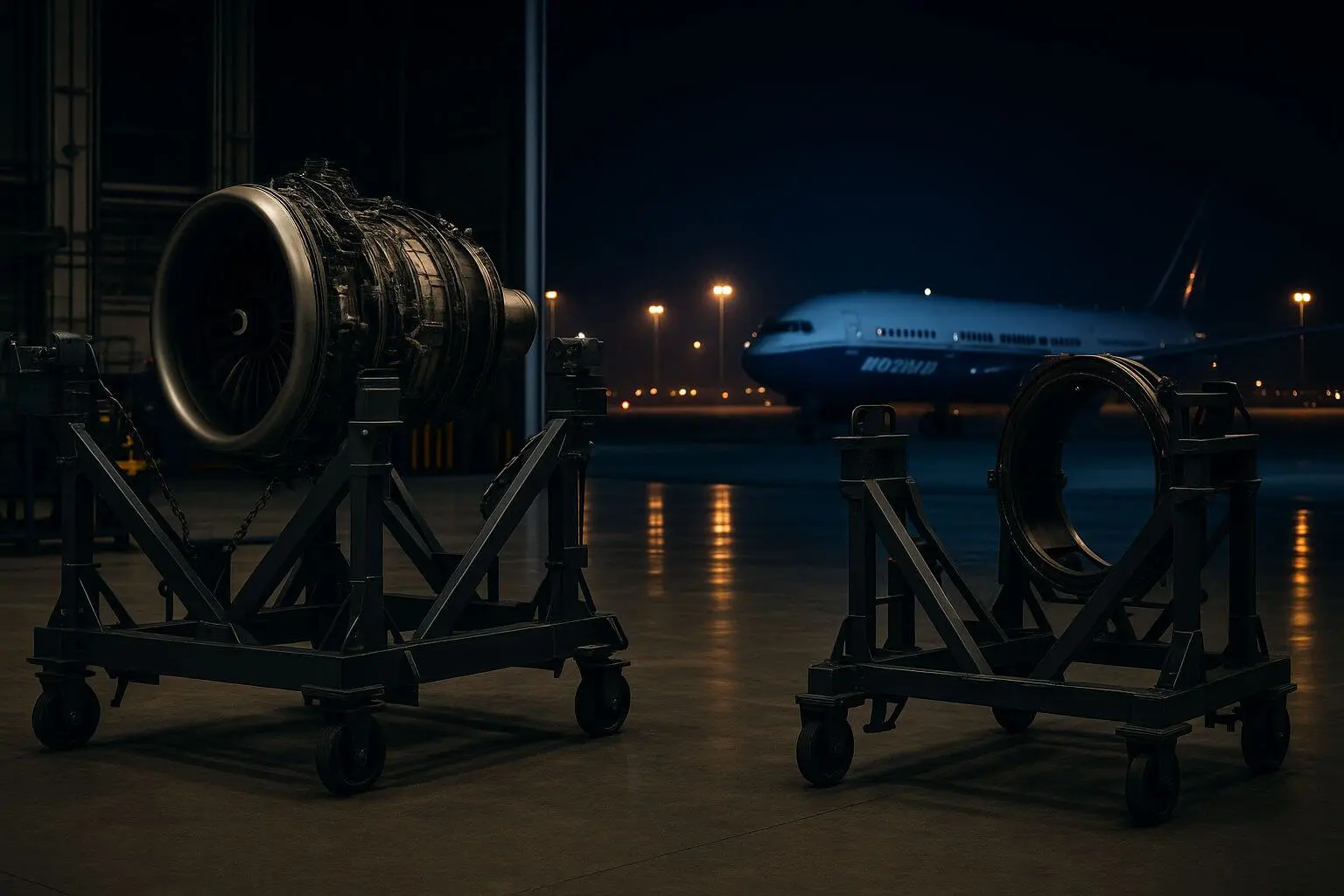The Definitive Guide to Aircraft Engine Stands
In the complex world of aviation maintenance, precision and reliability are non-negotiable. At the heart of efficient engine servicing operations lies a critical piece of ground support equipment that often goes unnoticed but plays an indispensable role in ensuring aircraft safety and operational efficiency. An aircraft engine stand serves as the foundation for secure engine handling, transportation, and maintenance procedures across the global aviation industry.
Modern aviation maintenance facilities depend on specialized equipment to manage the intricate demands of engine servicing. With the commercial MRO market projected to reach $1,026.8 billion between 2023 and 2032, and engine maintenance accounting for 46% of this demand at approximately $468.6 billion, the importance of reliable engine stands has never been more critical.
Understanding Aircraft Engine Stands: The Backbone of Aviation Maintenance
Aircraft engine stands represent sophisticated engineering solutions designed to support, transport, and position aircraft engines during maintenance, repair, and overhaul (MRO) procedures1. These specialized tools provide the stability and accessibility that maintenance crews require to perform precise work on engines worth millions of dollars.
Core Functions of Engine Stands:
- Secure Transportation: Moving engines safely between storage, maintenance bays, and aircraft
- Stable Work Platform: Providing technicians with safe, ergonomic access to engine components
- Storage Solution: Protecting valuable engines during extended storage periods
- Maintenance Support: Enabling complex repair and overhaul procedures with precision
The aviation industry encompasses countless aircraft models with diverse engine configurations, sizes, and designs1. Engine stands demonstrate remarkable versatility by adapting to various engine types, from turbofan engines in commercial jetliners to turboprop engines in regional aircraft.
The AE3007 Engine Stand: Engineering Excellence for Specific Applications
Among the most critical applications in regional aviation is the support of Rolls-Royce AE3007 engines, which power the popular Embraer ERJ-135 and ERJ-145 aircraft families. The specialized AE3007 engine stand (https://stands.aero/product/ae3007/) represents a pinnacle of engineering designed specifically for these applications.
AE3007 Engine Specifications and Requirements
The Rolls-Royce AE3007 represents a remarkable achievement in aerospace engineering, with over 3,400 units produced since its inaugural run in 1991. This turbofan engine’s technical specifications demand equally sophisticated support equipment:
| Specification | Details |
|---|---|
| Engine Weight | 751.6 kg (1,657 lbs) |
| Thrust Class | 8,000 lb thrust category |
| Applications | Embraer ERJ-135/145, Cessna Citation X |
| Architecture | Single-stage fan, 14-stage axial compressor |
| Control System | Full Authority Digital Engine Control (FADEC) |
Specialized Features of AE3007 Engine Stands
The AE3007 engine stand incorporates several critical design elements that ensure optimal support for this specific engine model:
Structural Integrity: Robust construction capable of supporting the engine’s weight distribution while maintaining stability during transport and maintenance operations.
Precision Mounting: Engineered mounting points that align perfectly with the AE3007’s attachment interfaces, ensuring secure connection and preventing stress concentrations.
Mobility Solutions: Integrated transportation features that facilitate safe movement within maintenance facilities and between locations.
Accessibility Design: Optimized positioning that provides maintenance technicians with comprehensive access to all engine components requiring service.
National Aero Stands: Global Leadership in Engine Stand Solutions
National Aero Stands (NAS) has established itself as the industry’s premier provider of aircraft engine transportation stands, with over nine years of specialized experience since its founding in 2016. The company’s growth trajectory demonstrates the critical importance of dedicated engine stand expertise in modern aviation maintenance operations.
Company Evolution and Expertise
National Aero Stands emerged from a strategic acquisition of Stands on Demand (founded in 2010), rapidly expanding to address the aviation industry’s critical need for flexible, cost-effective access to high-quality engine transportation stands. This focused approach has enabled NAS to develop unparalleled expertise in engine stand design, manufacturing, and service delivery.
Key Milestones in NAS Development:
- 2010: Stands on Demand established, pioneering engine stand leasing concepts
- 2016: National Aero Stands acquired Stands on Demand, accelerating growth
- 2024: Fleet expansion to over 300 engine stands worldwide
- 2025: Continued global expansion with enhanced service capabilities
Fleet Capabilities and Global Reach
With a fleet exceeding 300 units, National Aero Stands maintains one of the industry’s most comprehensive inventories of engine transportation stands. This extensive fleet enables the company to provide immediate solutions for diverse aircraft types and operational requirements across global markets.
Fleet Composition Highlights:
- Comprehensive Coverage: Stands for major engine families including CFM56, V2500, AE3007, and others
- Geographic Distribution: Strategic positioning across multiple continents for rapid deployment
- Maintenance Standards: Full-service maintenance facility ensuring peak equipment condition
- Inventory Management: Advanced utilization tracking systems optimizing equipment availability
Technical Specifications and Engineering Standards
Modern aircraft engine stands must meet stringent engineering requirements to ensure safety, reliability, and operational efficiency. The technical specifications for engine stands vary significantly based on the specific engine models they support, but several universal principles guide their design and construction.
Load Distribution and Structural Analysis
Engine stands must distribute loads effectively across their structural framework while maintaining stability under various operating conditions. The engineering analysis considers multiple load scenarios:
Static Load Conditions:
- Engine weight distribution during stationary positioning
- Asymmetric loading during maintenance procedures
- Environmental factors including wind loads and temperature variations
Dynamic Load Conditions:
- Transportation vibrations and acceleration forces
- Lifting and positioning operations
- Emergency braking scenarios during transport
Material Selection and Durability
High-quality engine stands utilize advanced materials engineered for aerospace applications:
| Component | Material | Properties |
|---|---|---|
| Primary Structure | High-strength steel alloys | Corrosion resistance, fatigue strength |
| Mounting Hardware | Aerospace-grade fasteners | Precision tolerance, reliability |
| Mobility Systems | Industrial-grade casters | Load capacity, maneuverability |
| Protective Elements | Engineered polymers | Impact resistance, chemical compatibility |
Operational Benefits and Economic Impact
The implementation of high-quality engine stands delivers measurable benefits across multiple operational dimensions, contributing to overall maintenance efficiency and cost optimization.
Maintenance Efficiency Enhancement
Engine stands significantly reduce aircraft turnaround times by streamlining engine handling procedures. Modern stands incorporate design features that minimize the time required for engine removal, transport, and reinstallation:
Time Savings Mechanisms:
- Enhanced Mobility: Improved maneuverability reduces positioning time
- Ergonomic Access: Optimized technician access reduces setup requirements
- Standardized Interfaces: Consistent mounting systems accelerate connection procedures
- Integrated Tooling: Built-in features eliminate need for additional equipment
Safety and Risk Mitigation
Professional-grade engine stands provide critical safety benefits that protect both personnel and valuable aircraft components:
Personnel Safety Features:
- Stable work platforms reducing fall risks
- Ergonomic design minimizing strain injuries
- Secure locking mechanisms preventing unexpected movement
- Clear sight lines improving situational awareness
Equipment Protection:
- Precision mounting preventing component damage
- Shock-absorbing systems during transportation
- Environmental protection during storage
- Secure retention preventing accidental release
Industry Applications and Market Segments
Aircraft engine stands serve diverse market segments within the aviation industry, each with specific requirements and operational challenges.
Commercial Aviation MRO
Commercial airlines and maintenance organizations represent the largest market segment for engine stands, driven by the need for efficient fleet maintenance operations. The Boeing 737-800 requires approximately $55.8 billion in engine maintenance over the next decade, while Airbus A320 aircraft demand totals around $52.3 billion.
MRO Facility Requirements:
- High-utilization stands for frequent engine changes
- Multiple engine compatibility for diverse fleets
- Rapid turnaround capabilities for schedule adherence
- Comprehensive maintenance support for stand equipment
Engine Leasing Companies
The engine leasing sector requires specialized solutions for managing engine portfolios across multiple geographic locations and customer bases.
Leasing Company Needs:
- Global logistics coordination for engine movements
- Standardized equipment for consistent operations
- Long-term reliability for extended lease periods
- Flexible deployment options for varying customer requirements
Regional Aviation Operators
Regional airlines operating aircraft like the Embraer ERJ family require specialized stands such as the AE3007 model for their specific engine maintenance needs.
Regional Operator Considerations:
- Cost-effective solutions for smaller fleet sizes
- Reliable equipment for remote location operations
- Efficient maintenance procedures for quick turnarounds
- Technical support for specialized engine types
Service Excellence and Global Support
National Aero Stands distinguishes itself through comprehensive service offerings that extend far beyond equipment provision. The company’s commitment to customer success encompasses 24/7 support capabilities and customized solutions tailored to specific operational requirements.
24/7 Support Infrastructure
Aviation operates continuously, and maintenance requirements can arise at any time. National Aero Stands maintains round-the-clock support capabilities to address urgent customer needs:
Support Service Components:
- Technical Assistance: Expert guidance for equipment operation and troubleshooting
- Logistics Coordination: Rapid deployment of equipment to customer locations
- Maintenance Support: Comprehensive repair and refurbishment services
- Emergency Response: Immediate assistance for critical operational needs
Customized Solutions for Diverse Requirements
Recognizing that every customer’s operational profile is unique, National Aero Stands develops tailored solutions that address specific challenges and requirements. COO Gail Holguin emphasizes the importance of understanding clients’ fleets, maintenance locations, and specific requirements to build truly effective solutions portfolios.
Customization Capabilities:
- Fleet Analysis: Detailed assessment of customer aircraft and engine types
- Operational Optimization: Solutions designed for specific maintenance workflows
- Geographic Considerations: Equipment positioning for optimal accessibility
- Integration Support: Seamless incorporation into existing maintenance procedures
Technology Integration and Future Developments
The aviation industry continues to evolve rapidly, driven by technological advancement and changing operational requirements. Engine stand technology must adapt to support these developments while maintaining the fundamental principles of safety and reliability.
Digital Integration and Monitoring
Modern engine stands increasingly incorporate digital technologies that enhance operational visibility and equipment management:
Digital Enhancement Features:
- Utilization Tracking: Real-time monitoring of equipment usage and location
- Predictive Maintenance: Advanced analytics for equipment condition monitoring
- Fleet Management: Centralized control systems for multi-location operations
- Performance Analytics: Data-driven insights for operational optimization
Sustainability and Environmental Considerations
Environmental consciousness drives innovation in engine stand design and operation, with manufacturers focusing on sustainable materials and energy-efficient systems:
Sustainability Initiatives:
- Material Selection: Emphasis on recyclable and environmentally friendly materials
- Energy Efficiency: Reduced power consumption for electrically-powered systems
- Longevity Design: Extended equipment life cycles reducing replacement frequency
- Maintenance Optimization: Efficient service procedures minimizing environmental impact
Selection Criteria and Best Practices
Choosing the appropriate engine stand requires careful consideration of multiple factors that impact both immediate operational needs and long-term strategic objectives.
Technical Compatibility Assessment
The foundation of engine stand selection lies in ensuring complete technical compatibility with target aircraft engines:
Compatibility Factors:
- Engine Model Specifications: Exact matching of stand capabilities to engine requirements
- Weight Capacity: Adequate load support with appropriate safety margins
- Dimensional Fit: Proper sizing for engine geometry and access requirements
- Interface Standards: Compatibility with existing maintenance equipment and procedures
Operational Environment Considerations
Engine stands must perform reliably across diverse operational environments, from climate-controlled hangars to outdoor maintenance areas:
Environmental Factors:
- Climate Conditions: Temperature, humidity, and precipitation resistance
- Facility Constraints: Spatial limitations and floor loading requirements
- Operational Frequency: Usage patterns and durability requirements
- Maintenance Access: Availability of service support and spare parts
Economic Analysis and Return on Investment
The decision to invest in engine stands, whether through purchase or lease, requires comprehensive economic analysis that considers both direct costs and operational benefits.
Cost-Benefit Evaluation Framework
Direct Cost Components:
- Initial Investment: Equipment purchase or lease costs
- Operational Expenses: Maintenance, storage, and transportation costs
- Personnel Requirements: Training and operational staffing needs
- Facility Modifications: Hangar or maintenance area adaptations
Operational Benefit Quantification:
- Maintenance Efficiency: Reduced turnaround times and labor costs
- Safety Improvements: Reduced risk of accidents and equipment damage
- Flexibility Enhancement: Ability to handle diverse maintenance requirements
- Competitive Advantage: Improved service capabilities and customer satisfaction
Leasing vs. Purchase Analysis
National Aero Stands pioneered the engine stand leasing model, providing flexible access to high-quality equipment without the complexities of ownership:
| Aspect | Leasing | Purchase |
|---|---|---|
| Initial Investment | Low capital requirement | High capital requirement |
| Flexibility | Easy equipment changes | Fixed equipment commitment |
| Maintenance | Included in service | Owner responsibility |
| Technology Updates | Access to latest models | Potential obsolescence risk |
| Cash Flow | Predictable monthly costs | Large upfront expenditure |
Quality Assurance and Regulatory Compliance
Aviation maintenance equipment must meet stringent quality standards and regulatory requirements to ensure operational safety and reliability.
Manufacturing Standards and Certifications
High-quality engine stands undergo rigorous manufacturing processes that ensure consistency and reliability:
Quality Control Processes:
- Material Certification: Verification of all materials and components
- Manufacturing Inspection: Comprehensive quality checks during production
- Performance Testing: Validation of load capacity and operational parameters
- Documentation Standards: Complete traceability and configuration management
Regulatory Compliance Framework
Engine stands must comply with various regulatory requirements depending on their operational environment and application:
Regulatory Considerations:
- Aviation Authority Requirements: Compliance with FAA, EASA, and other aviation regulations
- Safety Standards: Adherence to occupational safety and health requirements
- Environmental Regulations: Compliance with environmental protection standards
- International Standards: Conformity with ISO and other international specifications
Maintenance and Lifecycle Management
Effective engine stand management requires comprehensive maintenance programs that ensure equipment reliability and longevity while optimizing operational costs.
Preventive Maintenance Programs
National Aero Stands operates a full-service maintenance facility that provides comprehensive repair and refurbishment services:
Maintenance Program Elements:
- Regular Inspections: Scheduled assessments of equipment condition
- Component Replacement: Proactive replacement of wear items
- Performance Verification: Testing of critical functions and safety systems
- Documentation Management: Detailed maintenance records and compliance tracking
Lifecycle Optimization Strategies
Equipment Lifecycle Phases:
- Initial Deployment: Proper setup and integration procedures
- Operational Period: Regular use with preventive maintenance
- Performance Monitoring: Continuous assessment of equipment condition
- End-of-Life Planning: Refurbishment or replacement decisions
Future Outlook and Industry Trends
The aircraft engine stand industry continues to evolve in response to changing aviation requirements and technological advancement.
Market Growth Projections
The substantial growth in commercial MRO markets drives continued demand for engine stands and related equipment. With engine maintenance representing the largest portion of MRO spending, the importance of efficient engine handling equipment will continue to increase.
Technological Innovation Trends
Emerging Technologies:
- Advanced Materials: Lighter, stronger materials improving performance
- Automation Integration: Reduced manual handling requirements
- Connected Systems: IoT integration for enhanced monitoring and control
- Modular Design: Increased flexibility and adaptation capabilities
Engine stands represent a critical component in the complex ecosystem of aviation maintenance, providing the foundation for safe, efficient, and reliable engine servicing operations. As the industry continues to grow and evolve, the importance of high-quality, professionally managed engine stand solutions will only increase.
National Aero Stands has established itself as the global leader in this specialized field, combining over nine years of dedicated experience with a fleet of more than 300 units to serve customers worldwide. Through comprehensive service offerings, including 24/7 support and customized solutions, NAS continues to set the standard for excellence in aircraft engine stand provision.
The future of aviation maintenance depends on the continued evolution of specialized equipment and services that enable safe, efficient operations. Engine stands, though often overlooked, play an indispensable role in this ecosystem, supporting the critical work that keeps aircraft flying safely around the world.







